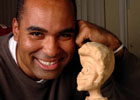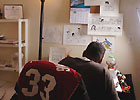|
 |
|
Esta página no está disponible en español. South Florida Sun-Sentinel Drawn From Life By Magaly Morales May 3, 2004
At last, a hero who looked like him, Cabrera thought. "There were, and still are, very few heroes of color portrayed on television, the movies and particularly, the funny pages," says the 31-year-old schoolteacher and artist from Fort Lauderdale. "Seeing one on the movie screen was a very important moment for me as a kid. I was really thrilled." Cabrera, who is a mix of black, Hispanic, Italian and Japanese, wanted to bring his very own hero of color to other young multiethnic Americans. So he created Silo Roberts, a newspaper comic strip featuring the misadventures of a mixed-race, middle child who lives in a single-parent household. "In the comic pages you'll find the voices of white America and of black Americans, too, in Curtis and Herb & Jamaal. The Hispanic community is represented, too, with Baldo," he says. "But until now, you couldn't find the voice and the struggles of the multiethnic person." Silo Roberts caught the eye of Jake Morrissey, managing editor of comics for United Media, which in April started syndicating the strip nationally. Morrissey also saw the growing need for ethnic characters, and found in Cabrera's Silo the perfect feature to fill this void. "What I was interested in was the fact that [the strip] came from a perspective by an artist who has a very varied background," says Morrissey. "A young schoolteacher whose family was as diverse as, basically, the nation." Being picked up for syndication is almost impossible. United Media alone receives more than 100 submissions a week from would-be cartoonists, and the syndicate launches only two or three new strips each year. "To pick mine out of that many, I mean, the odds are astronomical," Cabrera says. Cabrera -- himself a middle child who grew up in a single-parent home -- says he borrowed a lot from his own life for the strip. But he describes Silo as a lot braver than he was as a kid. "I was very shy and really didn't speak my mind the way Silo does," he says. "I guess you can say that, in a way, Silo is an idealized version of me." Silo's lifelong struggle to find his place in the world starts during a standardized test in elementary school. When asked to state his race, the fourth-grader stumbles and realizes he doesn't fit in any of the categories given. "That happened to me in real life," recalls Cabrera. "At first I used to become as confused as Silo, and after much inner debate, I would just mark `other.'" Born in a dream Cabrera was born in New York in 1973, and spent much of his youth in Miami Beach. His family spent a few years in Puerto Rico, where his parents were born. Cabrera's parents divorced when he was 10, and though Cabrera would see his father almost every weekend, he missed his daily presence in the house. "It definitely had some impact," he recalls. "It wasn't always easy for us, especially for my mom." It was in high school that the name Silo Roberts entered Cabrera's life, in a dream. Though Cabrera didn't know then what it meant, he nonetheless took it as a message that he had to do something with it. He started doodling to try to give a face to that name. At first he made him look a lot like himself, then changed it into a white kid and later to a black one. "All through high school and college, and until now, I had played with this character that sort of took a life of its own and became this comic strip," he says. At 17, Cabrera joined his mom and siblings in Wisconsin and lived there for 11 years. He attended the University of Wisconsin-Milwaukee, where he graduated with degrees in graphic design and fine arts. He worked as a graphic designer for a couple of years, but eventually quit to give stand-up comedy a try. He joined an improvisational comedy group called Comedy Sportz, where he picked up skills that he was later able to apply to his comic strip. "I would draw these characters, but I didn't know how to make them sound funny," recalls Cabrera. "It wasn't until after I started hanging out with those comedians in Milwaukee that I learned to really write a joke." Touring or teaching When it came time to make the decision to pursue a career in comedy and go on tour, Cabrera decided to quit. Life on the road wasn't for him, he thought. It was then that he decided to follow in his mother's footsteps and become a teacher. "That was really the catalyst for the comic strip to come into life the way it did, because I started hearing these kids talk and listening to what was in their minds and that transferred into what Silo is all about," explains Cabrera, who teaches fourth grade at Pembroke Lakes Elementary. In his class alone, there are eight or nine children with multiethnic backgrounds. "More and more, people of mixed races are claiming their cultural backgrounds. When Tiger Woods first became famous, most people described him as black. And while he was proud of his African-American heritage, he wanted to make sure people knew he had other races mixed," says Cabrera. "That inspired many of us who didn't like it when we were lumped in one group or were classified as `other.'" United Media's Morrissey recognizes this changing dynamic. "As we become more of a diverse place, with so many people coming from all over the world to live here, the sense of what America looks like and sounds like and thinks like and feels like is changing," he says. "What intrigued me about this particular comic strip was that Rob has managed to collect all of this into the life experience of this little boy, who is trying to figure out who he is while at the same trying to figure how he can make it through this world he doesn't really know." The strip, which will often be bilingual, emulates Cabrera's own household. And while Silo's race is a big part of the strip, so is the fact he's being raised by a single mother trying to balance a professional career while raising three kids. Just like Silo's mom, Diane, Cabrera's mother is a strong individual who was able to raise three kids and still continue to pursue her career as an educator. The character's siblings are also molded after Cabrera's older brother and little sister. "My siblings think it's cool. My sister, who is now 27, is thrilled that she has this quirky little personality in the strip," says Cabrera. "My brother loves the fact that I made him taller and muscular, but particularly loves that the character, Donny, is a little bit of a lady's man and a jock." No stereotypes With Silo, Cabrera wants to show a more realistic and positive side, so don't look for stereotypes in the story lines, he warns. Silo is a very good student who doesn't listen to rap or play basketball. Just like Cabrera, Silo isn't very athletic. "He is in fact a multilayered character with a lot of different dimensions to him," explains Cabrera. Cabrera has seen many kids like Silo in his own classroom. And from their struggle he gets a lot of ideas for his strip. "My students are really excited about my strip," he says. "Some of them weren't really interested in reading when they first started the year. But when I showed them that I was going to have this strip running in the newspapers, they have taken to reading the paper to see other comic strips." His strip, Cabrera says, has a positive message about how people of different races can get along, despite their differences and how those differences can actually compliment each other. "Just because kids this age will be reading Silo, I think it's important that the character represents multiethnicity well."
|



